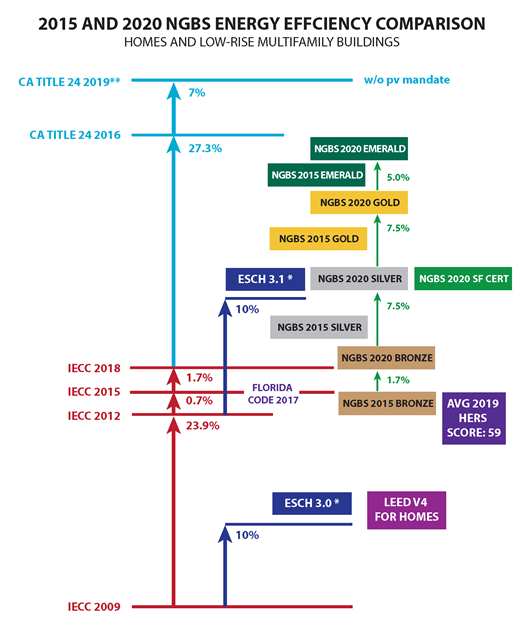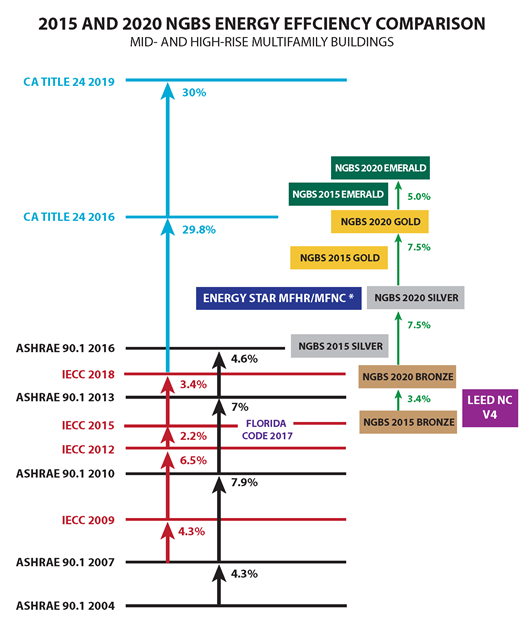

Earlier this year, ANSI approved the fourth version of the National Green Building Standard ICC-700 as an American National Standard. Now, builders and developers have a choice to seek NGBS Green certification based on either the 2015 NGBS or the 2020 NGBS. Which is the best version for your project and your market?
Some may presume that compliance with the 2015 NGBS would be less challenging and/or less expensive to achieve compliance. But, don’t be so quick to dismiss the 2020 as a more beneficial option. The 2020 NGBS Consensus Committee made several important improvements that warrant strong consideration before embarking on your next green building project.

Figure 1
NGBS Green is designed to be a voluntary, above-code program. So, one factor to consider is which building code version is in effect where you’re building. Each version of the NGBS sets a different code-minimum baseline. This ensures a level playing field nationally for buildings seeking NGBS Green certification. Typically, the biggest difference between the code minimum requirements and what’s required in the NGBS deals mostly with energy efficiency. Since energy efficiency improvements tend to add the most cost to a project, this is a logical place to start your analysis. The baseline of the 2015 NGBS is the 2015 IECC, the 2015 IBC (International Building Code), and the 2015 IRC (International Residential Code). The baseline of the 2020 NGBS is the 2018 IECC, the 2018 IBC, and the 2018 IRC. Buildings located in states that are on the 2009 IECC may want to consider the 2015 NGBS as a starting point. However, buildings in states that have already adopted the 2018 suite of I-codes will definitely want to consider the 2020 NGBS.
Using the 2015 vs. 2020 NGBS Energy Efficiency Comparison Chart (Fig. 1), you can see a home or low-rise multifamily building located in a state at the 2009 IECC seeking certification would have to be approximately 23% more energy efficient than a code-minimum home to earn 2015 NGBS Green certification at the Bronze level; and then approximately an additional 2% more energy efficient to earn 2020 NGBS Green certification at the same Bronze level. With such a small incremental increase in required efficiency, going for 2020 NGBS Green certification may make the most sense if it’s attainable within the project budget. For mid- to high-rise multifamily buildings, the energy efficiency levels are a little different, but not significantly (See Fig. 2).

Figure 2
But we all know a green home is not built on energy efficiency alone. For builders or developers who want more choices for green practices relating to lot selection, design, and development, the 2020 NGBS has a number of new practices that earn points toward certification, including those that promote car- and bike-sharing, bike storage, areas with high intersection density, and on-site recreation space.
In recognition of the fact that resilient buildings in areas susceptible to hurricanes, earthquakes, flooding, and fire, are more sustainable, the 2020 NGBS also includes voluntary practices that reward above-code resilient design practices. Likewise, through the inclusion of practices that earn points toward certification for incorporating universal design elements into a home or multifamily building, the 2020 NGBS acknowledges the importance of being able to age-in-place as an important component of sustainability. While the 2015 NGBS included some of these practices, builders using the 2020 NGBS for compliance can gain additional recognition for going “above and beyond” in these categories and others (Net Zero Energy, Smart Home, Wellness, and Zero Water) by attaining NGBS Green+ badges.
There are also special considerations favoring the 2020 NGBS for developers of mixed-use buildings wishing to earn certification for the entire building (not just the residential portion), as well as assisted living facilities, hotels, group homes, or student housing. Also, the 2020 NGBS offers a streamlined Certified path for higher-volume home builders that eliminates certification point counting by providing a single list of mandatory green practices. Compliant homes, townhouses, and duplexes will achieve an energy efficiency level roughly equivalent to the Silver certification level and must successfully incorporate a series practices, equipment, and systems focused on the most impactful green measures, such as moisture management, durability, water efficiency, and improved indoor quality.
Still not sure which way to go? Check out the NGBS version decision tree we’ve created to help. It’s designed to help builders, architects, and developers select the best NGBS version option for them. For more information on NGBS Green certification, visit HomeInnovation.com/Green.
***